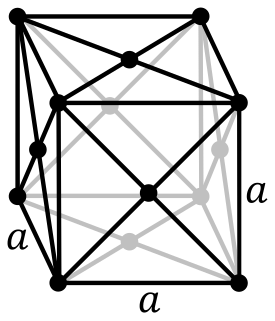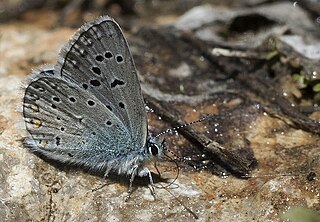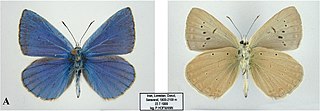The actinoid series encompasses the 15 metallic chemical elements with atomic numbers from 89 to 103, actinium through lawrencium. The actinoid series derives its name from the first element in the series, actinium. The informal chemical symbol An is used in general discussions of actinoid chemistry to refer to any actinoid.

Mendelevium is a synthetic element with the symbol Md and atomic number 101. A metallic radioactive transuranic element in the actinide series, it is the first element by atomic number that currently cannot be produced in macroscopic quantities through neutron bombardment of lighter elements. It is the third-to-last actinide and the ninth transuranic element. It can only be produced in particle accelerators by bombarding lighter elements with charged particles. A total of seventeen mendelevium isotopes are known, the most stable being 258Md with a half-life of 51 days; nevertheless, the shorter-lived 256Md is most commonly used in chemistry because it can be produced on a larger scale.
A period 7 element is one of the chemical elements in the seventh row of the periodic table of the chemical elements. The periodic table is laid out in rows to illustrate recurring (periodic) trends in the chemical behaviour of the elements as their atomic number increases: a new row is begun when chemical behaviour begins to repeat, meaning that elements with similar behaviour fall into the same vertical columns. The seventh period contains 32 elements, tied for the most with period 6, beginning with francium and ending with oganesson, the heaviest element currently discovered. As a rule, period 7 elements fill their 7s shells first, then their 5f, 6d, and 7p shells in that order, but there are exceptions, such as uranium.

The chalkhill blue is a butterfly in the family Lycaenidae. It is a small butterfly that can be found throughout the Palearctic realm, where it occurs primarily in grasslands rich in chalk. Males have a pale blue colour, while females are dark brown. Both have chequered fringes around their wings.

Polyommatus is a diverse genus of butterflies in the family Lycaenidae. Its species are found in the Palearctic realm.

Polyommatus eros, the Eros blue or common meadow blue, is a species of blue butterfly found in the Palearctic.

Polyommatus damon, the Damon blue, is a butterfly of the family Lycaenidae.

Polyommatus daphnis, the Meleager's blue, is a butterfly of the family Lycaenidae.

Ripart's anomalous blue is a butterfly in the family Lycaenidae.

Polyommatus (Plebicula) dorylas, the turquoise blue, is a butterfly of the family Lycaenidae. It is found in southern Europe, Asia Minor, the Ural Mountains, Caucasus and Transcaucasia. Its wingspan is 15–17 mm. The butterfly's common name comes from the dazzling bright blue colour of male's wings. The larvae feed on Anthyllis vulneraria. The butterfly flies from May to September in two generations. Habitats include flowery meadows in rocky areas at 500–2000 m.

Polyommatus thersites, the Chapman's blue, is a butterfly in the family Lycaenidae. It is found in southern Europe, Morocco, Lebanon, Asia Minor, Iran and across the Palearctic to Siberia and Tian Shan.

Polyommatus myrrha is a species of butterfly in the family Lycaenidae. It was first described as Lycaena myrrha by Gottlieb August Wilhelm Herrich-Schäffer in 1851 in the six volume Systematische Bearbeitung der Schmetterlinge von Europa. This rare species has been found in Anatolia area of Turkey. and in the Zangezur Mountains, which is inhabited by subspecies P. m. cinyraeaNekrutenko & Effendi, 1979.

Polyommatus atlantica, the Atlas blue, is a butterfly in the family Lycaenidae. It was described by Henry John Elwes in 1905. It is found in North Africa.
Polyommatus avinovi is a butterfly in the family Lycaenidae. It was described by Yuri Shchetkin in 1980. It is found in Central Asia.
Polyommatus zarathustra, the Zarathustra blue, is a butterfly of the family Lycaenidae. It was described by Eckweiler in 1997. It is endemic of southern slope of the Meghri Mountains in Armenia and nearby Arasbaran Mountains in northern Iran. Armenia is inhabited by subspecies P. z. neglecta. It inhabits forests alternated with dry steppe-like areas at elevations of 1400–1900 m above sea level. The species is included in the Red Book of Animals of the Republic of Armenia as endangered EN B1a+B2a.

Polyommatus karindus is a butterfly of the family Lycaenidae. It was described by Norman Denbigh Riley in 1921. It is only known from the Iranian Zagros Mountains. The habitat consists of dry slopes, gorges and plateaus with xerophyte or steppe vegetation, sometimes wooded areas from 1,800 up to 2,800 meters.

Polyommatus nephohiptamenos, or Higgins's anomalous blue, is a butterfly of the family Lycaenidae described by J. Brown and John G. Coutsis in 1978. It has an IUCN Red List status of near threatened.












